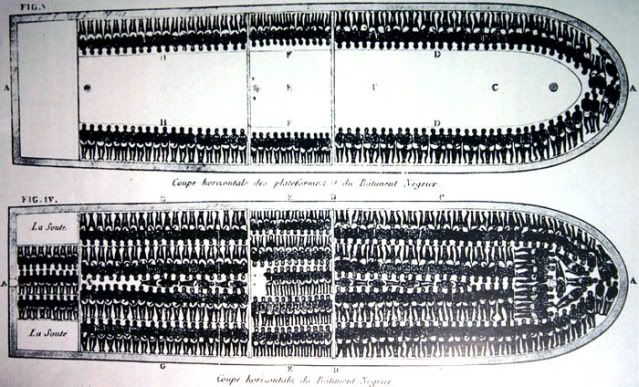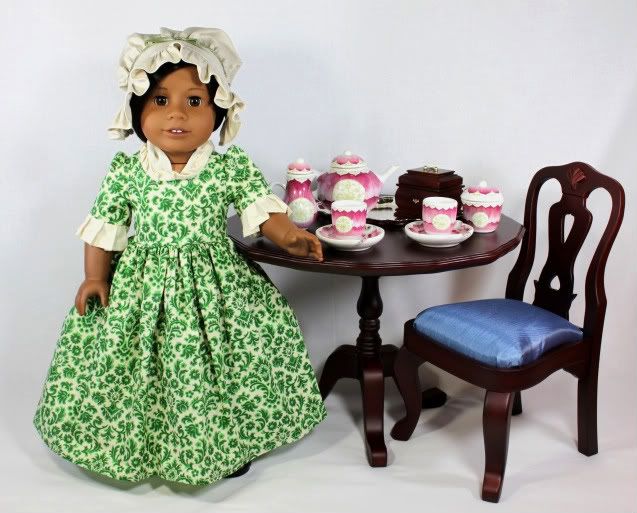Gutentag! Here we are at Day Two of Colonial Week!
Yesterday we started to learn more about the Royall family. One of the important aspects of their history is their dependency on slaves for their wealth. Isaac Sr. began his business ventures on Antigua as a slave trader- selling over 121 slaves in one year alone. He took his earnings and invested them in a sugar plantation, sugar refinery, and rum distillery.
In the American colonies we often think of slavery as only existing in the South. However, the slave trade was an important business for the North and slaves were owned throughout the region. In fact Massachusetts was the first colony (of the original 13) to legalize human bondage in 1641, and it didn't abolish slavery until 1783. For over 100 years New England played a key role in the "Triangle Trade," building slave ships, distilling rum, and exporting a variety of goods that were traded for slaves.
Africans were loaded onto slave ships by the hundreds but during their journey across the Atlantic usually fifty percent or more of them died. Being shackled and stuffed into the ship like sardines for the voyage was cruel torture. But the traders only saw these slaves as property to be bought, sold or discarded like livestock. Below you can see a diagram of how ships were filled with their human cargo; each of those black figures is one person.
In the North there were no cash crop plantations like in the South where tobacco, cotton and rice were grown. So while Southern farms might own hundreds and hundreds of slaves to tend the crops, in the North households would usually only own a few slaves. As we talked about yesterday, Isaac Royall's ownership of 27 slaves in Massachusetts was not the norm for families there.
If you go to Medford, Massachusetts today you can visit the Royall House where the Royall family lived until the Revolutionary War. It was the main building on that 600 acre estate we talked about which was called Ten Hills Farm, or Royallville. Next door, as you can see in the photo below, is the wood and brick building which once functioned as the kitchen and main slave quarters for the estate.
During its history about 60 slaves are recorded as living at Ten Hills Farm. They produced rum, wool, cider, and hay, and tended livestock. Some worked as field hands, while others had higher status as boatmen, domestic servants, cooks, and “body slaves” (valets and ladies’ maids). In the North it was much easier for slaves to learn trades than in the South.
Today we are going to talk about one Royall slave in particular: Belinda. She was captured by slave traders near the Volta River in what we call today Ghana in Western Africa when she was twelve years old. Belinda served the Royall family for over fifty years well into old age. In 1783 she petitioned for her freedom from the Royall household and essentially sued for support-- sort of like a pension. This legal document has allowed us to learn a lot about her-- much more information than we know about most slaves at this time.
In our pictures today Angelina Sheldon has dressed up as Belinda and is wearing a green and ivory dress purchased from Ebay seller All*My*Friends*Are*Dolls- an adult collector who is downsizing her collection. It is a beautiful dress made from a uniquely patterned fabric. We added in the neck-scarf (fichu) and mob cap for our photoshoot. And again, our doll is posed by Felicity's table, chair and tea set.
In 1775, three days before the Battle of Lexington, Isaac Jr. (Mary and Elizabeth's father) left Massachusetts and fled to Nova Scotia. While he reportedly had Patriot sympathies, most of his business ties and friends were Loyalists. So staying in the colonies was going to be a problem. His property was eventually seized by the Patriots and Ten Hills Farm served as an army headquarters for them, and it even housed George Washington at one point.
Once known as one of grandest households in North America with the best parties, best wines, and best hospitality, the estate of the Royall family was no more. Most of their slaves were left behind in the colony to survive on their own. Belinda moved to Boston to join the growing community of free blacks that was located there.
Isaac Jr. died of smallpox in England in 1781, and in his will it was stated that Belinda could choose to be inherited by his daughter (Mary) or become a free woman. It was at this point that the petition came into play. She officially gained her freedom and a yearly salary of 15 pounds for herself and her daughter. This was essentially one of the first times in history that a slave is compensated for his/her service. Sort of like a reparation-- which was granted by the General Court of Massachusetts. Four years later the amount went unpaid and she took legal action to get her payment. That is the last time we hear about her in historical documents. The date and circumstances of her death are unknown.
Stay tuned for Day Three of Colonial Week when Mary will help us to learn more about the Royalls, colonial fashion, and why tea was so important!




No comments:
Post a Comment